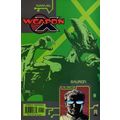Bettws-y-Coed, Conwy - Pont-y-Pair bridge - L&NW Railway postcard c.1908
- Condition : Used
- Dispatch : 2 Days
- Brand : None
- ID# : 182696594
- Quantity : 1 item
- Views : 219
- Location : United Kingdom

- Seller : justthebook (+1704)
- Barcode : None
- Start : Thu 20 Jun 2019 18:05:31 (EDT)
- Close : Run Until Sold
- Remain : Run Until Sold
Checks/Cheques
 for 1 item(s) edit
for 1 item(s) edit
Shipping Calculator
More Listings from This Seller view all
Seller's Description
- Postcard
- Picture / Image: Pont-y-Pair, Bettws-y-Coed, [Conwy borough]
- Publisher: London and North Western Railway
- Postally used: yes
- Stamp: Edward VII half d. light green
- Postmark(s): date and place unclear, cds
- Sent to: Miss J, Crutchley?, Rest Lea, Knightstone Road, Weston-super-Mare
- Notes / condition:
Please ask if you need any other information and I will do the best I can to answer.
Image may be low res for illustrative purposes - if you need a higher definition image then please contact me and I may be able to send one. No cards have been trimmed (unless stated).
------------------------------------------------
Postage & Packing:
Postage and packing charge should be showing for your location (contact if not sure).
No additional charges for more than one postcard. You can buy as many postcards from me as you like and you will just pay the fee above once. Please wait for combined invoice. (If buying postcards with other things such as books, please contact or wait for invoice before paying).
Payment Methods:
UK - PayPal, Cheque (from UK bank) or postal order
Outside UK: PayPal ONLY (unless otherwise stated) please. NO non-UK currency checks or money orders (sorry).
NOTE: All postcards are sent in brand new stiffened envelopes which I have bought for the task. These are specially made to protect postcards and you may be able to re-use them. In addition there are other costs to sending so the above charge is not just for the stamp!
I will give a full refund if you are not fully satisfied with the postcard.
----------------------------------------------
Text from the free encyclopedia WIKIPEDIA may appear below to give a little background information (internal links may not work) :
*************
Betws-y-Coed ("Prayer house in the wood", Welsh pronunciation: [ˈbɛtʊs ə ˈkɔɨd]) is a village and community in the Conwy valley in Conwy County Borough, Wales.
The name Betws or Bettws is generally thought to be derived from the Anglo-Saxon Old English bed-hus—i.e. a bead-house: a house of prayer, or oratory.[1] The earliest record of the name is Betus, in 1254.[2]
Betws-y-Coed is one of the honeypot locations in Snowdonia. It lies in the Snowdonia National Park, in a valley near the point where the River Conwy is joined by the River Llugwy and the River Lledr, and was founded around a monastery in the late sixth century. The village grew very slowly with the development of the local lead mining industry. In 1815, the Waterloo Bridge, built by Thomas Telford to carry the London to Holyhead road (now the A5) across the River Conwy and through the village, brought considerable transport-related development. The village became a major coaching centre between Corwen (to the east) and Capel Curig (to the west) on the Irish Mail route from London to Holyhead, which led to the improvement of the roads south to Blaenau Ffestiniog and north to Llanrwst and Conwy. It is a primary destination for the purpose of road signs.
Construction of Betws-y-Coed railway station in 1868 heralded the arrival of the railway line from Llandudno Junction railway station, and resulted in the village's population increasing by around 500.
The village has a large village green which is the playing field for the local football team. The green is bounded on its western side by the A5 trunk road, with 19th century buildings, including shops, hotels, and the Church of St Mary. This church was built on the site of a former cockpit and fairground, and although it is of early English appearance, it was completed as recently as 1873, the internal roof timbers testifying to this relatively young age. The interior also features various types of stone: local bluestone, sandstone (and floor tiles) from Ancaster, and black serpentine from Cornwall. The square bell tower was added in 1907, and the integral church hall was added in the 1970s, the commemorative stone being laid by the Earl of Ancaster in 1976.
Listing Information
| Listing Type | Gallery Listing |
| Listing ID# | 182696594 |
| Start Time | Thu 20 Jun 2019 18:05:31 (EDT) |
| Close Time | Run Until Sold |
| Starting Bid | Fixed Price (no bidding) |
| Item Condition | Used |
| Bids | 0 |
| Views | 219 |
| Dispatch Time | 2 Days |
| Quantity | 1 |
| Location | United Kingdom |
| Auto Extend | No |




















